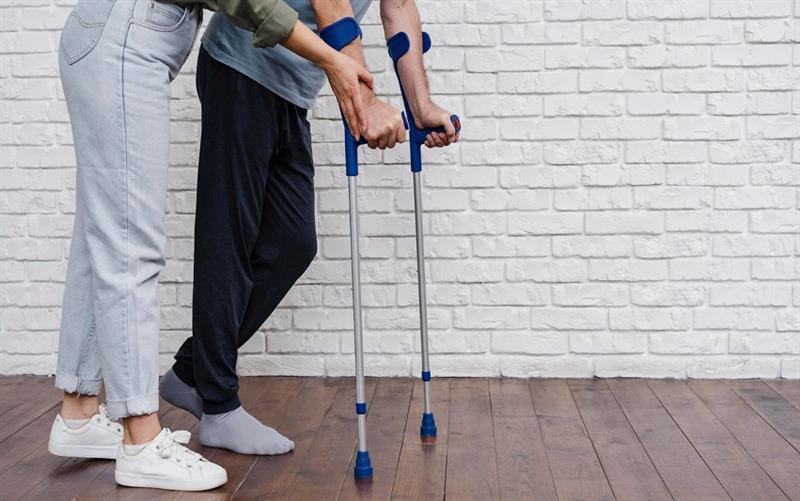
Crutches have long been recognized as essential tools for individuals facing mobility challenges, providing support and assistance in navigating the world. While their primary function is to aid movement, the power of crutches extends far beyond being mere mobility aids. In this blog, we explore the multifaceted roles that crutches play in enhancing not only physical mobility but also mental well-being, independence, and resilience.
Crutches are more than just tools for physical support; they are symbols of resilience, independence, and community. The power of crutches lies in their ability to transform lives, not only by aiding mobility but also by challenging societal norms and fostering a sense of connection and inspiration. As we recognize the multifaceted roles of crutches, we contribute to creating a world where everyone, regardless of physical ability, is empowered to live a fulfilling and meaningful life.
1. Physical Support and Rehabilitation:
The fundamental role of crutches is to offer physical support to those with injuries, disabilities, or recovering from surgeries. By redistributing weight and providing stability, crutches aid in maintaining balance and preventing further strain on injured limbs. They are indispensable during the rehabilitation process, allowing individuals to gradually regain strength and mobility.
2. Independence and Freedom:
Crutches empower individuals to maintain a level of independence that might otherwise be compromised. Whether navigating the home, workplace, or public spaces, crutches enable users to move with relative freedom. This newfound independence plays a pivotal role in fostering a sense of autonomy and self-reliance, crucial elements for mental well-being.
3. Building Resilience:
Living with crutches requires a significant adjustment, both physically and mentally. Users develop resilience as they adapt to the challenges of daily life, overcoming obstacles that might seem insurmountable initially. The journey of learning to use crutches fosters mental strength and perseverance, qualities that extend beyond the physical realm.
4. Community and Connection:
The use of crutches often brings individuals into a community of people facing similar challenges. This shared experience can lead to the formation of supportive networks where individuals exchange advice, encouragement, and understanding. Crutches become not just tools for movement but symbols of unity, connecting people through shared triumphs and struggles.
5. Breaking Stereotypes and Redefining Beauty:
Society's perception of disability has been evolving, thanks to various movements advocating for inclusivity and diversity. Crutches play a role in challenging traditional notions of beauty and capability. Users of crutches showcase that physical differences do not diminish one's worth or potential. The visibility of individuals using crutches contributes to a more inclusive narrative, encouraging society to embrace diversity.
6. Inspiration and Role Modeling:
People using crutches often become inadvertent role models for resilience and determination. Their journey becomes an inspiration to others facing challenges, demonstrating that limitations can be overcome with the right mindset and support. The power of crutches extends beyond the individual user, impacting the broader community by fostering a culture of empathy and understanding.
7. Enhancing Mental Health:
Crutches play a crucial role in maintaining and improving mental health. The physical limitations that necessitate the use of crutches can often lead to frustration or feelings of dependency. However, successfully navigating daily life with crutches fosters a sense of accomplishment, positively impacting mental well-being.
8. Adaptability in Various Environments:
Crutches are designed to be versatile, allowing users to adapt to different environments seamlessly. Whether indoors, outdoors, on stairs, or uneven terrain, crutches provide the adaptability needed for users to participate in a wide range of activities, enhancing their overall quality of life.
9. Promoting Physical Activity:
Contrary to the misconception that crutches restrict physical activity, they can actually encourage users to stay active. Crutch users often engage in modified exercises to maintain fitness levels and support their overall health, contributing to a more active and fulfilling lifestyle.
10. Educational Impact:
In educational settings, crutches become a symbol of determination and the pursuit of knowledge. Students using crutches showcase resilience, proving that physical challenges need not hinder academic success. The presence of individuals using crutches in educational institutions contributes to a more inclusive and supportive learning environment.
11. Facilitating Social Inclusion:
Crutches act as facilitators of social inclusion by providing individuals with the means to participate in social activities. Whether attending social events, gatherings, or recreational activities, crutches enable users to engage with their communities, reducing social isolation.
12. Emergency Preparedness:
Crutches are valuable tools in emergency situations. Users can evacuate buildings or navigate through crowded spaces with greater ease, contributing to their overall safety. This aspect of crutch utility is often overlooked but can be crucial in unforeseen circumstances.
13. Fashion and Personal Expression:
Modern crutch designs and accessories allow users to personalize their mobility aids, turning them into fashion statements. From colorful crutch covers to custom grips, individuals using crutches can express their personal style, challenging stereotypes and promoting self-expression.
14. Empowering Children and Youth:
For younger individuals facing mobility challenges, crutches play a vital role in empowering them to actively participate in social and recreational activities. This early introduction to adaptability and resilience can shape a positive mindset that carries into adulthood.
15. Advocacy and Awareness:
The visibility of crutch users contributes to increased awareness about mobility challenges and disabilities. This visibility can lead to advocacy efforts, influencing policy changes, and promoting a more inclusive and accessible society for all.